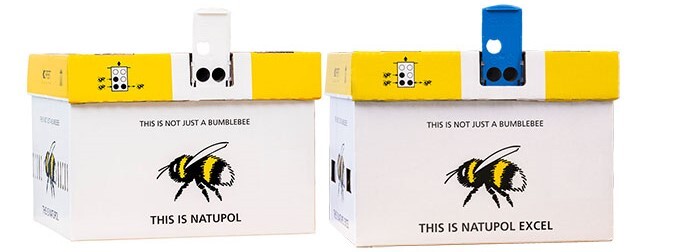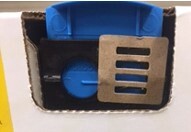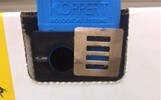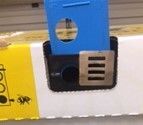Hive Set Up and Important Tips

Our Natupol Excel and Natupol Excel Startup solutions are perfect for pollinating a wide range of crops, including, but not limited to, round and plum tomatoes, peppers, cherry or snack tomatoes, strawberries, and eggplants.
If you are looking to pollinate an outdoor space or would like help selecting the right number of hives regardless of your set up please reach out to us directly. We offer larger hives that consist of 4 hives per Quad which are ideal for outdoor pollination. This page is meant to help you set up your single Natupol hive. Please see below for how to uncap the sugar water in your hive and open the bee tab door to the open position, as well as much more. If you have any questions please don't hesitate to reach out to our live chat service in the bottom right hand corner of the browser, or call us at +18106328750 our live agents are happy to assist!
Precautions
Bumblebees are attracted by colorants and odors, as well as by blue clothing, after shave, make-up etc. Bumblebees are not aggressive but they might sting in self-defense. This usually only leads to local itchy swelling. However, sometimes an oversensitive reaction can occur, in these cases, consult a doctor immediately, including:
- Pain and itching on other places than where stung, sometimes over the entire body.
- Red skin, blisters, respiratory problems, sickness, sneezing, irritation of nostrils, throat or eyes.
To get started, watch this video tutorial on setting up your hive.
A) Receiving and Unpacking Your NATUPOL® Hive
Your hive(s) will ship UPS 1-day. The nectar tank in the hive must be uncapped and the bee tab door must be pulled up to the "open" position. Please refer to the “Attention” sticker located on the cardboard lid for instructions. Please feel free to contact us at Tel. +18106328750 if you have any questions.
1. Open the shipping container carefully to avoid disturbing the hive. Keep the hive temperature between 60°F and 80°F until you are ready to place it in the greenhouse.
• On the end of the box, you will find a number indicating the week the bees were shipped.
• For Excel hives, a second number indicates the week you should remove the hive from the greenhouse.
2. You may inspect the hive by opening the hinged lid of the NATUPOL® box. View the bees through the plastic top of the hive. You will see bees walking on the insulation that covers the brood.
• DO NOT disturb the bees by tapping on the box.
• If you have any questions about what you see, please give us a call.
B) Placing Your NATUPOL® Hive
• Place the hive on a stand or bench between the plants at the beginning of an aisle.
• Keep the hive on a stable, horizontal surface. Don’t place it on vibrating or swinging poles.
• Keep the hive away from bright sunlight, especially when greenhouse temperature is above 85°F. In warm conditions, provide shade on all sides.
• Don’t put the hive in front of fans or close to a vent intake.
• Avoid locations where people gather. Both bees and people are more comfortable if the hive entrance is away from people.
C) Opening and Closing the Flight Door
The foraging of the bees can be controlled by adjustment of the flight door. The flight door is a blue plastic plate, located on the right-hand side of the box. There are three positions for the door:
1. Closed Position (Shown below): This is how your hive will arrive. This position does not allow bees to get out or come in.
2. Bee-home Position (Shown below): When the plate is moved up so that only the single, top flight hole is open. Use this position when you want to collect the bees in the hive and not allow them to leave (if you are moving the hive). All bees will be in the hive 1-2 hours after setting the bee-home position.
3. Open Position (Shown below): Pull gently upwards until both of the lower flight holes are open. This position allows bees to come and go so they can fly in your crop.
• Use the open position to begin pollination.
• When you receive the colony, the open position entrance/exit hole will be covered with fiber tape. Please leave the tape in position. The fiber tape is in place to allow the bees an hour or two to calm down after the shipping process.
• After you have placed the hive, simply open it as described above and walk away. The bees will chew their way through the fiber tape in 1 to 2 hours. If after 24 hours the bees have not chewed through the fiber tape, you may remove it.
• If you close the exit door, remember to open it again. Forgetting this can cause the death of the colony.
Protecting Your NATUPOL® Hive from Ants
Ants are attracted by the high sugar content of the nectar bag within the hive. Protect the hive from ants by:
• Applying a band of glue or heavy grease around the hive support.
• Removing other routes by which ants can reach the hive, such as leaves that touch the hive.
• Placing the hive support(s) in a container of water, to create a barrier that ants cannot cross.
What to Do When You Have to Spray Chemicals
Many chemical treatments can kill bees. If you are unsure about the toxicity of a pesticide, please check out our database of compatabilities here, (Koppert One). If you have any questions or can not find the chemical you are looking for please reach out to us. In most cases, our database will help you to determine the appropriate action.
Options include:
• Collect the bees into the hive, and keep the door closed until it is safe for the bees to forage.
(Confine the bees by closing the entrance after the bees return at sunset, or by setting the door to the “bee-home” position 2 hours before closing the entrance.)
• Remove the hive from the greenhouse. Collect the bees, close the door, and remove the hive for as long as necessary (though no more than 3 days). Store the hive on a stable, vibration-free surface at moderate temperature (65-70°F). Before removing the hive, note its original location so that it can be returned to the same place, and in the same orientation.
• Find an alternative chemical treatment. Some persistent pesticides are simply incompatible with bumblebees. Biological pest control is compatible with bumblebees.
Supplemental Feeding Guidelines
Regarding supplemental feeding, the approach depends on the number of blooms present and the duration for which you need to restrict the bees from foraging.
• Short-term Foraging Restriction: If you need to prevent the hive from foraging for one day and plan to re-open it the next day, no supplemental feeding is necessary. You can achieve this by pushing down the tab to the re-entry only door position.
• Extended Foraging Restriction: If you need to shut the hive for more than one day, it is recommended to provide supplemental feeding. You can do this by pushing ½ to 1 teaspoon of pollen through the top grate of the hive.
• Resuming Foraging: When you want the bees to start foraging again, it is important to stop the supplemental feeding. This will reactivate their interest in foraging and encourage them to resume their natural activity.
How greenhouse conditions can affect Your NATUPOL® Hive
Fans can kill many bees. Use a minimum of 1/4" mesh screen to protect bees.
CO2 Lines: Don't place hives too close to CO2 High concentrations of CO2 will make the bees much less active, resulting in lower pollination levels.
Materials: Some types of plastic affect the light quality, interfering with the bee’s flight and reducing pollination performance.
Grow Lights: Bumblebees can be used in combination with grow lights. However, in the absence of natural daylight, the lights can distract the bees from their normal flight behavior. If you use grow lights, observe the following points:
- Always shut off the lights at least one hour before sunset. The bees will return to their hive in a natural way at the end of the day.
- Keep lights at least 2 feet above the crop.
- If lights are used during the night, be sure to set the flight door to the bee-home position one hour before sunset, and reopen the hive in the morning after sunrise.

